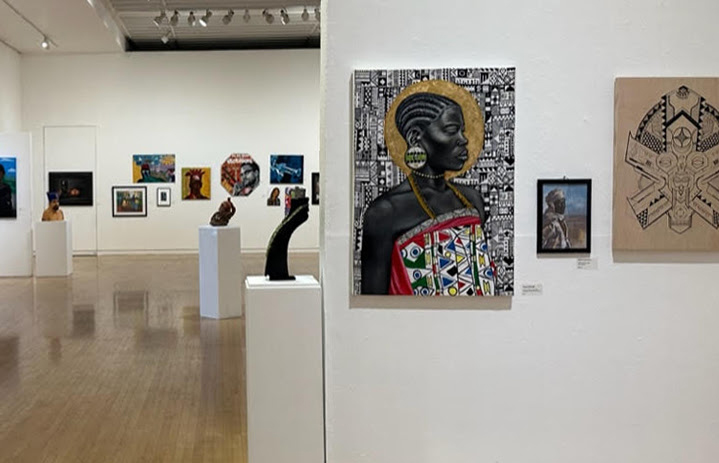‘Art of the African Diaspora’ reveres Black history, present, future
Weblink: https://dailycal.org/2023/02/23/diaspora
Katherine Shok | February 23, 2023
After stepping through the Richmond Art Center’s entrance, visitors immediately begin celebrating Black excellence, as laid bare in the “Art of the African Diaspora.” Gracing the center’s main gallery in every medium imaginable, the exhibition in its entirety unveils how Black identity shifts, evolves and culminates uniquely through the lens of each artist.
Originally a salon for Black artists, first titled “Colors of Black” and then “The Art of Living Black,” the exhibition has supported Black visibility, representation and community in the arts since 1989. Annually, the series develops a new creative collective through the main exhibition and its Bay Area satellites, as artists display their recent work.
132 artists are part of the 2023 exhibition, displaying a diverse set of backgrounds, mediums and inspirations. The expanse of talent is embodied by the three 2022 Artistic Achievement Award Winners, Pryce Jones, Cynthia Brannvall and Derrick Bell.
Jones’ abstract yet sharp paintings greet visitors to the exhibition. These portraits are cutting — a slash of warm yellow acrylic marks a woman’s cheekbone, while bright green accentuates the shadows of her face.
In “Night Rider,” a large acrylic painting on canvas, a man’s proud face is outlined in dark blacks and grays, yet is offset by the warm red and yellow textures of his facial features. The painting evokes solitude in a chaotically colorful canvas: Two images of a person on horseback ride beside a block of text about a man riding at night, in contrast to the sunflower yellows and purples that occupy much of the painting.
Brannvall’s six displays are mixed-media collages. Political maps of Africa and the United States are overlaid by physical maps and photographs of people — some staring into the camera, inviting attention, while others look away sinking into their collages.
Occasionally, Brannvall’s use of space is blocky, such as in “Fulfillment,” where a man is collaged to sit above a cutout of the Earth, a slice of the ocean and two political maps. His posture is satisfied and comfortable, with legs and arms folded.
Contrastingly, “Descendants” brings to mind Pangea, with a physical map reaching upwards from the left corner towards three overlaid political maps spanning the top third of the canvas. A woman in a white dress contemplatively sits in the center; through her, Brannvall creates historical and modern perspectives on the woman’s journey.
Bell similarly turns to history and his roots for inspiration in his acrylic paintings. His three works appear like stylized stainless glass panes, sections of bright paint set starkly apart through their black boundaries.
In “Ancestral Contributions,” the painted panes are not glassily inflexible or flat; textures of clothing are apparent through Bell’s variation in shading and coloration. The folds of three women’s cream dresses look soft to the touch, and the group is swankily dressed for a celebration. One man holds a woman above his head; with only her skirt visible, she is unseen yet appears to be the focal point of the piece, alongside another woman in a blouse adorned with shells, proffering an empty plate.
A thousand gorgeous details clamor for attention in the exhibition’s main gallery.
There, stunning handmade necklaces of green and brown stone, titled “Spirit Quest” by Donna Gatson. Here, a collage-giclee print on canvas in tribute to Jimi Hendrix, “Taste of Purple Haze” by Frederick S. Franklin. Everything on the canvas looks to be made of fruits and vegetables; a Hendrix composed of peppers strums a cantaloupe guitar, eyes closed in musical ecstasy, as cherries rain around him. Exuberance and celebration leap from the work, leaving one wishing for a mouthful of purple haze.
Wooden carvings, photographs, sculptures and a spray-painted piece all individually mark aspects of the Black experience. By drawing from as many artistic talents as possible, as indiscriminately as possible, the exhibition honors the cultural wealth of the diaspora. Appreciation and reflection on Black identity through emotion, spirituality and history are vulnerably on display, leaving visitors awed by the exhibition’s collective and individual strength.
“Art of the African Diaspora” will be exhibited at the Richmond Art Center until March 18th.

